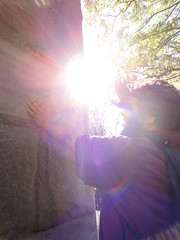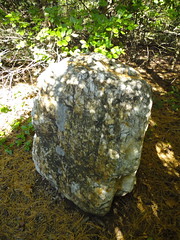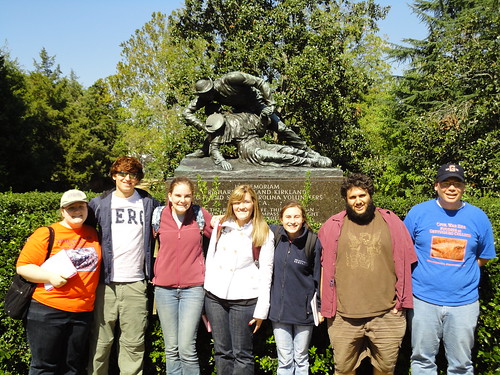Our day began at dawn. Well, maybe not dawn, but 7:00 am felt pretty early on Friday. The drive to Fredericksburg, Virginia was probably one of the quietest we’ve had so far. But as we unloaded the bus, we were all excitement as we were honored to meet our guide for Fredericksburg and Chancellorsville, staff historian Donald Pfanz.
 We began our tour at the breathtakingly picturesque Chatham, the headquarters of Edwin Sumner and a hospital for the wounded during the Battle of Fredericksburg. The front of the house overlooks the scenic Rappahannock, the river dividing the Union and Confederate armies in November and December 1862. As Donald explained Burnside’s struggles throughout the campaign and his attempts to cross the river, we studied the difficult nature of the terrain encountered by the Union troops. The troubles faced by Union soldiers seemed almost insurmountable, adding to the drama of the battle. It was difficult to imagine the amount of suffering that took place on the beautiful grounds of Chatham as it was covered with the wounded and dying during the battle.
We began our tour at the breathtakingly picturesque Chatham, the headquarters of Edwin Sumner and a hospital for the wounded during the Battle of Fredericksburg. The front of the house overlooks the scenic Rappahannock, the river dividing the Union and Confederate armies in November and December 1862. As Donald explained Burnside’s struggles throughout the campaign and his attempts to cross the river, we studied the difficult nature of the terrain encountered by the Union troops. The troubles faced by Union soldiers seemed almost insurmountable, adding to the drama of the battle. It was difficult to imagine the amount of suffering that took place on the beautiful grounds of Chatham as it was covered with the wounded and dying during the battle.
 Throughout the course of the morning, we traveled across both sides of the Confederate line. We started on the Confederate right, where Jackson and his men held the line against the assaults of Meade’s men. However, at the famous Marye’s Heights on the Confederate left the futility of the battle made itself known. Standing behind the stonewall defended by Confederate troops, it was difficult to imagine a better defensive position. On Marye’s Heights, we also saw the memorial to young Confederate Sergeant Richard Kirkland, better known as the Angel of Marye’s Heights. After the intense fighting of the Heights had slightly died off, Kirkland requested permission to take water to the wounded Union soldiers who cried out in pain and fear across the wall. After he was refused permission on account of the danger involved, Kirkland took it upon himself to cross the wall. Once the Union soldiers saw what he was doing, the intermittent firing stopped and a cheer went up among the Union soldiers. Sergeant Kirkland lost his life at Chickamauga the next year.
Throughout the course of the morning, we traveled across both sides of the Confederate line. We started on the Confederate right, where Jackson and his men held the line against the assaults of Meade’s men. However, at the famous Marye’s Heights on the Confederate left the futility of the battle made itself known. Standing behind the stonewall defended by Confederate troops, it was difficult to imagine a better defensive position. On Marye’s Heights, we also saw the memorial to young Confederate Sergeant Richard Kirkland, better known as the Angel of Marye’s Heights. After the intense fighting of the Heights had slightly died off, Kirkland requested permission to take water to the wounded Union soldiers who cried out in pain and fear across the wall. After he was refused permission on account of the danger involved, Kirkland took it upon himself to cross the wall. Once the Union soldiers saw what he was doing, the intermittent firing stopped and a cheer went up among the Union soldiers. Sergeant Kirkland lost his life at Chickamauga the next year.
The second half of our day was spent on the Chancellorsville battlefield, the site of what some call Lee’s greatest victory. The battlefield terrain here also proved difficult to maneuver. The overgrown Wilderness area, where another campaign would take place in 1864, posed serious problems to soldiers fighting there, and seeing the ground first hand made these difficulties evident.
 Through the afternoon, we followed General Thomas “Stonewall” Jackson’s final days. We stopped at the clearing where Jackson and Lee had their famed final meeting, and the wooded area where Jackson was shot by his own men in the confusion of twilight. Here, we found ourselves once more face to face with the memorialization of Jackson. In 1880, a group of men placed an unmarked boulder to honor Jackson’s memory near the site of his injury. Later, another more formal memorial was placed to honor Jackson. Both monuments indicate the level of ardor reserved for Jackson within the Southern mythology.
Through the afternoon, we followed General Thomas “Stonewall” Jackson’s final days. We stopped at the clearing where Jackson and Lee had their famed final meeting, and the wooded area where Jackson was shot by his own men in the confusion of twilight. Here, we found ourselves once more face to face with the memorialization of Jackson. In 1880, a group of men placed an unmarked boulder to honor Jackson’s memory near the site of his injury. Later, another more formal memorial was placed to honor Jackson. Both monuments indicate the level of ardor reserved for Jackson within the Southern mythology.
We spent a beautiful day on the battlefields of Fredericksburg and Chancellorsville thanks to the interpretive skills of our guide Donald Pfanz. Before heading back to the Appleford we stopped to eat at Perkins, complete with a full discussion of the sights of the day. After a long bus ride home, we arrived back in Gettysburg at 10:30pm, ready for some rest and relaxation. The rest was greatly needed to get us ready for a battle near and dear to each of us: Gettysburg.

No comments:
Post a Comment